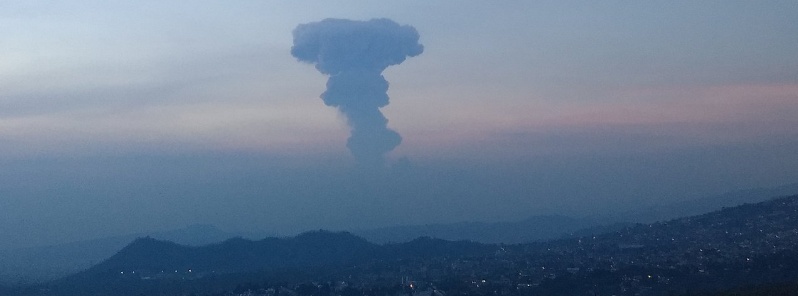Powerful eruptions at Popocatepetl volcano, ash to 12.8 km (42 000 feet) a.s.l., Mexico

Several significant eruptions took place at Popocatepetl volcano, Mexico on June 17, 2019. The volcanic ash cloud rose up to 12.8 km (42 000 feet) above sea level.
The first eruption started at 11:44 UTC (06:44 local time) followed by another one at 12:04 UTC (07:04 LT). According to the Washington VAAC, volcanic ash was observed rising up to 8.4 km (28 000 feet) above sea level, moving SW. Update posted 13:08 UTC mentions ash rising up to 9.7 km (32 000 feet) a.s.l.
At 14:01 UTC, satellite imagery revealed new ash cloud moving west at 8.5 km (28 000 feet) while another volcanic ash (from the previous explosion) rose up to 10.7 km (35 000 feet) a.s.l.
Another explosion took place at 17:40 UTC (12:40 LT), ejecting ash up to 8 km (26 200 feet).
By 18:15 UTC, the initial ash cloud rose up to 12.8 km (42 000 feet) a.s.l.
Another explosion took place at 20:21 UTC, ejecting ash up to 9.4 km (31 000 feet) a.s.l.






In 24 hours to 15:00 UTC on June 17, Popocatepetl volcano monitoring network detected 187 exhalations, accompanied by water, gas and light amounts of gas.
#Mexico El #Volcán mexicano #Popocatépetl lanza tres fumarolas de ceniza Vía @AFPespanol #AFP https://t.co/r60vT91eNY pic.twitter.com/DI5VC5DxVX
— Aroguden (@Aroguden) June 18, 2019
Some stunning images of the recent activity at #Popocatepetl https://t.co/JMvohq4UEY pic.twitter.com/4roPajKEvi
— Mel Bowles (@Melly_Rocks) June 18, 2019
El volcán #Popocatépetl amanece con ligeras emisiones de vapor de agua y gases que se dispersan hacia el suroeste de Puebla. El semáforoen #AmarilloFase2 #FelizMartes informa @PC_Estatal (Piloto Jaime del Río, tomada ayer, lunes) pic.twitter.com/DWnPHT0xus
— Tribuna Vigila (@TribunaVigila) June 18, 2019
Amaneció enojado el #Popocatépetl porque es #lunes así se ve desde Tlalpan, sur de la CDMX pic.twitter.com/Z98OdoP04f
— Elia Calderón (@Elia_RCG) June 17, 2019
Buenos dias #Popocatépetl pic.twitter.com/1ZxOJEeAyI
— . liliana (@verkana) June 17, 2019
Así, después de la explosión mañanera del #Popocatépetl
: @Chrismol1708 pic.twitter.com/esLcPhrgqy
— Sopitas (@sopitas) June 17, 2019
¡Don Goyo amanece enojado! #Popocatépetl registra nueva explosión https://t.co/kmG6hFoMwg pic.twitter.com/XMmIb8937t
— Milenio.com (@Milenio) June 17, 2019
This morning’s eruption #Popocatépetl #Popocatepetl pic.twitter.com/0ZT5O54jrr
— Dylan (@DylanJBrennan) June 17, 2019
Geological summary
Volcán Popocatépetl, whose name is the Aztec word for smoking mountain, rises 70 km (44 miles) SE of Mexico City to form North America's 2nd-highest volcano. The glacier-clad stratovolcano contains a steep-walled, 400 x 600 m (1 312 x 1 968 feet) wide crater.
The generally symmetrical volcano is modified by the sharp-peaked Ventorrillo on the NW, a remnant of an earlier volcano.
At least three previous major cones were destroyed by gravitational failure during the Pleistocene, producing massive debris-avalanche deposits covering broad areas to the south. The modern volcano was constructed south of the late-Pleistocene to Holocene El Fraile cone.
Three major plinian eruptions, the most recent of which took place about 800 CE, have occurred from Popocatépetl since the mid Holocene, accompanied by pyroclastic flows and voluminous lahars that swept basins below the volcano. Frequent historical eruptions, first recorded in Aztec codices, have occurred since precolumbian time. (GVP)
Featured image: Popocatepetl volcano erupting on June 17, 2019. Credit: Elia Calderon

Commenting rules and guidelines
We value the thoughts and opinions of our readers and welcome healthy discussions on our website. In order to maintain a respectful and positive community, we ask that all commenters follow these rules:
We reserve the right to remove any comments that violate these rules. By commenting on our website, you agree to abide by these guidelines. Thank you for helping to create a positive and welcoming environment for all.